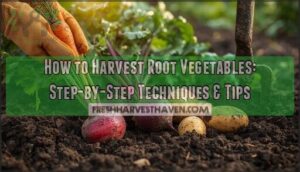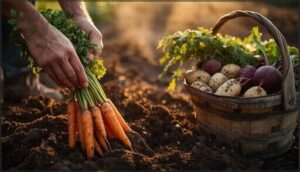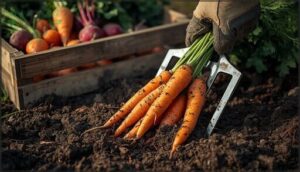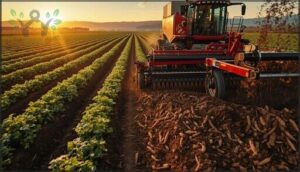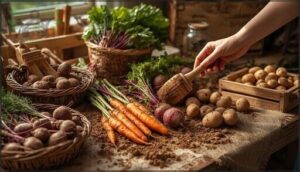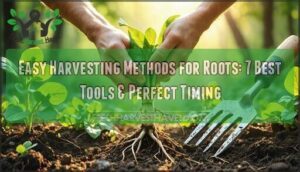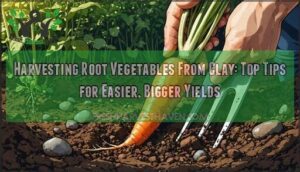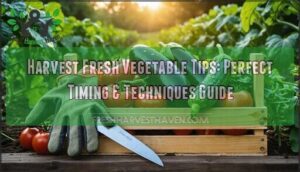This site is supported by our readers. We may earn a commission, at no cost to you, if you purchase through links.
Pull a carrot at the wrong moment, and you’ll end up with a stub in your hand and the rest still buried in the ground. Dig too aggressively around beets, and you’ll slice right through their tender skin. Harvesting root vegetables isn’t just about yanking them from the soil—it’s about timing, technique, and knowing how each crop behaves underground.
Whether you’re working a small garden plot or managing acres of production, the way you lift your roots affects everything from storage life to market value. Getting your hands on the right harvesting techniques for root vegetables means fewer losses, better quality, and crops that actually make it from field to table in prime condition.
Table Of Contents
Key Takeaways
- Harvest timing matters more than most growers realize—pull carrots when shoulders show at the soil surface and beets at golf-ball size, because waiting too long gives you woody, bitter roots that won’t store well.
- Dawn harvesting beats midday by a mile, with roots holding 12% more sweetness and 25% better storage life when you dig before 9 a.m. while overnight sugars are still high.
- Mechanical harvesters slash labor costs by 86% (from 250-300 man-hours per hectare down to just 34), paying for themselves in under six months for potato operations while cutting worker injuries from repetitive bending.
- Bruising during harvest costs you serious money and quality—cushioning equipment chains, killing vines two weeks early to toughen skins, and keeping soil temperature between 45-65°F can cut damage by 25-30% and extend storage life to 3-5 months.
What Are Root Vegetables?
Root vegetables are exactly what they sound like—crops that grow beneath the soil, storing nutrients in their enlarged roots, tubers, or bulbs. These underground powerhouses include everything from carrots and beets to radishes and turnips, each with its own peculiarities in terms of growing and harvesting.
Let’s break down what makes these crops unique, how they grow, and why they’re worth including in your rotation plan.
Common Types of Root Vegetables
You’ll find plenty of root vegetables worth growing in your garden. Potatoes lead the pack—they make up 80% of starchy vegetable consumption in America. Carrots are another favorite, known for their high yields and vitamin A content.
Sweet potatoes pack even more nutrition, delivering 107% of your daily vitamin A needs. Don’t overlook beetroot, turnips, and parsnips either—they’re reliable producers with solid market demand.
These vegetables are healthy foods that offer many nutritional benefits.
Growth Habits and Characteristics
Root vegetables share fascinating growth patterns that directly affect your harvest timing. These crops develop in stages—first establishing leaves, then channeling energy below ground into storage organs. Understanding their habits helps you get the most out of garden yields:
- Biomass Allocation: Carrots and beets prioritize root storage during vegetative phases, building up reserves before flowering.
- Root Morphology: Secondary growth expands diameter as storage tissues accumulate nutrients.
- Environmental Factors: Temperature and soil health influence root extension rates—compacted soil slows development and affects crop maturity.
Radishes can develop root-to-shoot ratios exceeding 2.4 under ideal conditions, while carrots build specialized storage parenchyma that signals ripeness indicators you’ll recognize at harvest. The soil’s biological components greatly influence root development.
Importance in Crop Rotation
Beyond understanding how your root crops develop, you’ll see even bigger benefits when you rotate them strategically through your garden beds. Crop rotation improves soil health by breaking pest cycles and boosting beneficial microbes.
Alternating root vegetables with legumes can increase nitrogen by 20–40%, while diversified rotations reduce disease loads by 40–60%. This practice delivers yield gains of 10–25% and prevents erosion naturally—smart economics for any grower.
Determining The Right Harvest Time
Knowing when to pull your root vegetables from the ground makes all the difference between a mediocre harvest and a truly great one. Get the timing wrong, and you’ll end up with crops that are too small, too woody, or starting to rot.
Let’s look at what signals it’s time to harvest, what factors might change your schedule, and when during the day you should actually be out there digging.
Signs of Maturity for Popular Root Crops
Knowing when your vegetables have crossed the finish line makes all the difference between a crisp, sweet carrot and a woody disappointment. Carrot maturity signs include visible shoulders at the soil surface and bright orange color—usually 55 to 100 days after sowing. Potato harvest cues involve yellowed foliage and skins that resist scraping.
For beets, look for golf-ball-sized roots with exposed shoulders around 55 to 70 days. Radish harvest timing is simpler: they’re ready when roots push above soil and measure 1 to 2 inches across, generally within 30 days for spring varieties. Turnip size guide suggests harvesting at 2 to 3 inches diameter for peak tenderness.
Factors Affecting Harvest Timing
Even though you’ve watched for maturity signals, Weather Impacts can shift your harvest timing by weeks—heavy rain in September may drop vegetable ripening rates by up to 20%. Soil Conditions, Crop Variety, and Rotation Schedules all play a role, while Pest Management protects quality.
Stable moisture boosts root yields 15–20%, so when you harvest vegetables depends on more than calendar dates alone.
Best Time of Day for Harvesting
Dawn is your best friend when harvesting vegetables—cooler morning temperatures keep roots crisp and sweet. Morning Sugar Content peaks after overnight starch conversion, while Temperature Effects on flavor development remain minimal before 9 a.m.
- Vegetables retain 12% more sweetness when gathered early
- Storage Longevity increases by up to 25% with dawn harvest timing
- Crispness Factors improve as roots hold overnight moisture
- Industry Recommendations consistently favor pre-9 a.m. collection for best time of day to harvest
Step-by-Step Manual Harvesting Techniques
Harvesting root vegetables by hand doesn’t require fancy equipment, but doing it right makes all the difference between a bin full of perfect produce and a pile of nicked, damaged crops. The key is working with the soil and plants rather than fighting against them.
Let’s walk through what you’ll need and how to handle each step so your harvest stays intact from ground to storage.
Tools Needed for Manual Harvesting
You don’t need a truckload of fancy equipment for manual harvesting—just the right basics. Grab a sturdy spade or trowel for loosening soil, a digging fork to lift without bruising, and a root lifter if you’re working with cassava or stubborn tubers.
Add pruning shears for trimming foliage, plus padded gloves and knee pads. These simple tools make harvesting techniques safer and far more efficient for home gardeners tackling garden produce.
Preparing The Soil and Plants
Before you harvest, set your root crops up for success with smart garden care. Water consistently—about 1 inch weekly—to avoid woody roots and support uniform growth.
Thin seedlings early: 2–3 inches for carrots, 4–6 inches for turnips. Check soil health by maintaining a loose, airy structure at least 24 inches deep.
Good moisture protocols and weed prevention now mean cleaner harvesting later.
Proper Methods for Lifting and Gathering
Once the soil’s just right, you can start the real work. Use a broad-tined fork to lift roots gently—insert it 12–15 cm below the tips and loosen the soil before pulling.
Sequential gathering works best: separate crowns from roots, then sort by size right in the field. For home gardeners, this harvest method cuts post-harvest labor by 30% and prevents breakage.
Minimizing Damage and Loss
Gentle handling matters more than you think—rough treatment during manual harvests can destroy up to 20% of your crop. Here’s how to protect your produce quality:
- Choose sharp, appropriate tools for clean cuts without crushing tissue
- Never throw or drop vegetables into bins—bruising invites decay
- Line containers with padding to absorb shocks during transport
- Fill harvest bins only halfway to prevent weight-related damage
- Handle roots just once before storage to minimize postharvest losses
Storage conditions and curing techniques finish what proper harvest timing and soil preparation started—they reduce water loss and help wounds heal naturally.
Mechanical Harvesting Methods and Innovations
If you’re working with larger fields or commercial operations, mechanical harvesting can save you time and money. Modern root vegetable harvesters have come a long way, combining multiple tasks into one efficient process.
Let’s look at the types of machines available, how they work, and what they can do for your bottom line.
Types of Root Vegetable Harvesters
Farmers today can choose from several mechanical harvesting options to match their operation’s scale and needs. Self-Propelled Harvesters work independently across large fields, while Tractor-Mounted Units attach to your existing equipment for solid efficiency.
Trailed Harvesters offer versatility for smaller farms, and Crop-Specific Models target particular vegetables like potatoes or carrots. Modular Harvesters adapt to multiple crops, giving you flexibility as your harvesting methods evolve throughout the season.
How Mechanical Harvesting Works
Once you’ve chosen your harvester, understanding the process helps you improve results. Here’s how mechanical harvesting works in the field:
- Opening the soil bed: A V-shaped share cuts 180–220 mm deep, lifting roots intact with minimal breakage
- Extracting and transporting: Twin clamps grip stems while rubber conveyors move roots upward, removing 80% of attached soil
- Sorting and collecting: Vibrating separators filter out debris as roots move to storage bins
Automation innovations and agricultural technology keep advancing these harvesting methods.
Efficiency, Cost, and Labor Benefits
Beyond understanding how machines operate, you need to know the bottom line. Mechanical harvesting slashes labor costs by cutting requirements to just 34 man-hours per hectare—compared to 250-300 for manual methods. That’s 86% labor savings. You’ll see payback periods under half a year for potatoes, with cost reductions hitting 85%.
Mechanical harvesting cuts labor costs by 86%, dropping requirements from 250-300 man-hours per hectare to just 34
Plus, eliminating repetitive bending and lifting improves worker safety considerably during harvest time.
Post-Harvest Handling and Storage Tips
Getting your root vegetables out of the ground is just the beginning—what you do next makes all the difference in how long they’ll last. Proper handling right after harvest protects your hard work and keeps vegetables fresh for weeks or even months.
Let’s walk through the key steps that’ll help you get the most out of your harvest, whether you’re selling at market or stocking your own pantry.
Cleaning and Sorting Root Vegetables
After harvesting vegetables, proper postharvest handling starts with smart cleaning and sorting. Washing techniques range from gentle brushing under cool water to mechanical sorting machines that boost performance efficiency by 80% while cutting labor impact dramatically.
You’ll prevent disease by removing soil quickly—because bruised roots decay faster—and mechanical systems let you process 400 kg per hour. Choose your harvest method wisely.
Storage Methods for Maximum Freshness
Once you’ve cleaned your harvest, storage methods make or break your vegetables’ shelf life. Proper postharvest handling means matching each crop to its ideal conditions—because root vegetables demand precision.
- Best Temperature: Keep carrots, beets, and parsnips at 32–40°F with 90–95% humidity for 4–6 months of freshness
- Humidity Control: Store potatoes at 40–50°F in darkness; onions need drier conditions around 55–65% humidity
- Traditional Methods: Root cellars, clamping in straw-lined trenches, or burying in damp sand extend storage naturally
- Modern Technologies: Digital monitors and controlled-atmosphere chambers reduce spoilage by tracking conditions precisely
- Storage Lifespan: Most roots last 4–8 months when you maintain proper fruit and vegetable storage protocols
Preventing Bruising and Spoilage
When bruises hit your root vegetables, you’re watching money and quality walk away. Mechanical damage during harvest causes most problems, costing potato growers hundreds of millions yearly.
Your harvest timing matters—pull crops between 45°F and 65°F to cut bruising risk. Use these strategies:
| Prevention Strategy | Impact on Quality |
|---|---|
| Cushion harvester chains | Reduces bruising 25% |
| Kill vines 14–21 days early | Toughens skins naturally |
| Irrigate week before digging | Softens clods, protects tubers |
| Calibrate equipment daily | Maintains consistent handling |
| Store at 3–5°C with humidity | Extends shelf life 3–5 months |
Your postharvest handling and sorting technologies determine crop quality—gentle transfer systems slash spoilage 30% in commercial operations.
Preparing Root Vegetables for Market or Home Use
After postharvest handling keeps your crop quality high, smart cleaning techniques and storage methods become your next priorities. Whether you’re heading to market or stocking your kitchen, proper preparation boosts marketability and freshness.
- Brush off soil gently—scrubbers reduce damage while removing dirt from harvesting vegetables
- Sort by size and quality—separate premium produce from seconds for different market tiers
- Cool crops quickly—rapid chilling extends shelf life and meets market trends for freshness
- Trim tops carefully—leave half-inch stems on beets and radishes to prevent moisture loss
- Pack with protection—cushioned containers prevent bruising during transport and home preparation
Frequently Asked Questions (FAQs)
What pests commonly damage root vegetables during harvest?
Think of pests as underground thieves, stealing your hard work. Root maggot damage, nematode infestation, white grub attacks, cabbage maggot, and soilborne pathogens commonly threaten vegetables, crop quality, and harvesting success.
How does soil type affect harvesting difficulty?
Sandy soil speeds up harvesting vegetables by 60% due to lower resistance, while clay soil increases labor and root damage by 25-50%.
Soil density directly impacts harvesting efficiency, affecting both harvest method choice and vegetables’ quality.
Can root vegetables be harvested in winter?
When harvest season stretches past autumn, you’re not out of luck. Many root vegetables thrive in winter soil—parsnips, Jerusalem artichokes, and horseradish stay harvestable even after frost, especially with mulch protection.
What are the signs of over-mature root crops?
When root vegetables pass peak ripeness, you’ll notice texture degradation—they turn woody and fibrous. Flavor changes too, becoming bitter.
Watch for yellowing leaves, surface cracks, and oversized bulbs protruding from soil as key maturity indicators.
How do you harvest root vegetables in clay soil?
Like digging through peanut butter, clay soil prep demands patience. Extraction techniques using tool leverage ease harvest timing. Loosen soil first, then lift gently.
Post-harvest, soil restoration maintains soil health for future harvesting vegetables.
Conclusion
The proof is in the pudding,” as they say—and with root vegetables, it’s in the harvest. Master your harvesting techniques for root vegetables, and you’ll pull clean, intact crops that store longer and taste better.
Whether you’re using a garden fork or a mechanical lifter, the right method at the right time makes all the difference. Treat your roots with care from soil to storage, and they’ll reward you with quality that speaks for itself.
- https://www.archivemarketresearch.com/reports/vegetable-harvesting-systems-469079
- https://docs.google.com/forms/d/1GAQr3Kn1cURCVHUA82hAga1Wv8DCH0IuqDLRUrOpN7M/viewform?ts=63f4f653&entry.1515682415=https://www.merriam-webster.com/dictionary%2Fharvest
- https://premium.britannica.com/mw-unabridged/?utm_source=mw&utm_medium=inline-def&utm_campaign=evergreen
- https://amaraorganicfoods.com/blogs/blog/america-s-veggie-report-card
- https://worldpopulationreview.com/country-rankings/vegetable-production-by-country

